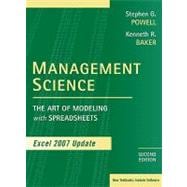
| Introduction | |
| Models and Modeling | |
| Why Study Modeling? | |
| Models in Business | |
| Models in Business Education | |
| Benefits of Business Models | |
| The Role of Spreadsheets | |
| Risks of Spreadsheet Use | |
| Challenges for Spreadsheet Users | |
| Background Knowledge for Spreadsheet Modeling | |
| The Real World and the Model World | |
| Lessons from Expert and Novice Modelers | |
| Expert Modelers | |
| Novice Modelers | |
| Organization of the Book | |
| Summary | |
| Modeling In A Problem-Solving Framework | |
| Introduction | |
| The Problem-Solving Process | |
| Some Key Terms | |
| The Six-Stage Problem-Solving Process | |
| Mental Models and Formal Models | |
| Influence Charts | |
| A First Example | |
| An Income Statement as an Influence | |
| Principles for Building Influence | |
| Two Additional Examples | |
| Craft Skills for Modeling | |
| Simplify the Problem | |
| Break the Problem into Modules | |
| Build a Prototype and Refine It | |
| Sketch Graphs of Key Relationships | |
| Identify Parameters and Perform Sensitivity Analysis | |
| Separate the Creation of Ideas from Their Evaluation | |
| Work Backward from the Desired Answer | |
| Focus on Model Structure, not on Data Collection | |
| Basic Excel Skills | |
| Introduction | |
| Excel Prerequisites | |
| The Excel Window | |
| Configuring Excel | |
| Manipulating Windows and Sheets | |
| Navigation | |
| Selecting Cells | |
| Entering Text and Data | |
| Editing Cells | |
| Formatting | |
| Basic Formulas | |
| Basic Functions | |
| Charting | |
| Printing | |
| Help Options | |
| Summary | |
| Advanced Excel Skills | |
| Introduction | |
| Keyboard Shortcuts | |
| Controls | |
| Cell Comments | |
| Naming Cells and Ranges | |
| Advanced Formulas and Functions | |
| R1C1 Reference Style | |
| Mixed Addresses | |
| Nesting Calculations | |
| Parameterization | |
| Advanced Functions | |
| Recording Macros And Using VBA | |
| Recording a Macro | |
| Editing a Macro | |
| Creating a User-Defined Function | |
| Summary | |
| Spreadsheet Engineering | |
| Introduction | |
| Designing a Spreadsheet | |
| Sketch the Spreadsheet | |
| Organize the Spreadsheet into Modules | |
| Start Small | |
| Isolate Input Parameters | |
| Design for Use | |
| Keep It Simple | |
| Design for Communication | |
| Document Important Data and Formulas.Designing a Workbook | |
| Use Separate Worksheets to Group Similar Kinds of Information | |
| Design Workbooks for Ease of Navigation and Use | |
| Design a Workbook as a Decision-Support System | |
| Building a Workbook | |
| Follow a Plan | |
| Build One Worksheet or Module at a Time | |
| Predict the Outcome of Each Formula | |
| Copy and Paste Formulas Carefully | |
| Use Relative and Absolute Addressing to Simplify Copying | |
| Use the Function W | |
| Table of Contents provided by Publisher. All Rights Reserved. |
The New copy of this book will include any supplemental materials advertised. Please check the title of the book to determine if it should include any access cards, study guides, lab manuals, CDs, etc.
The Used, Rental and eBook copies of this book are not guaranteed to include any supplemental materials. Typically, only the book itself is included. This is true even if the title states it includes any access cards, study guides, lab manuals, CDs, etc.